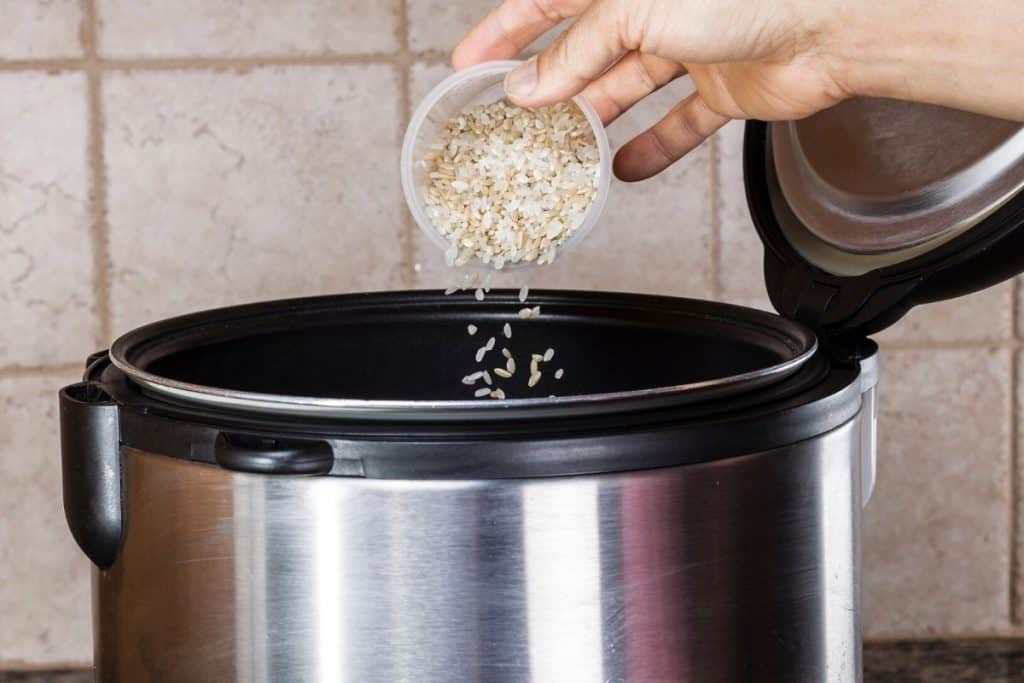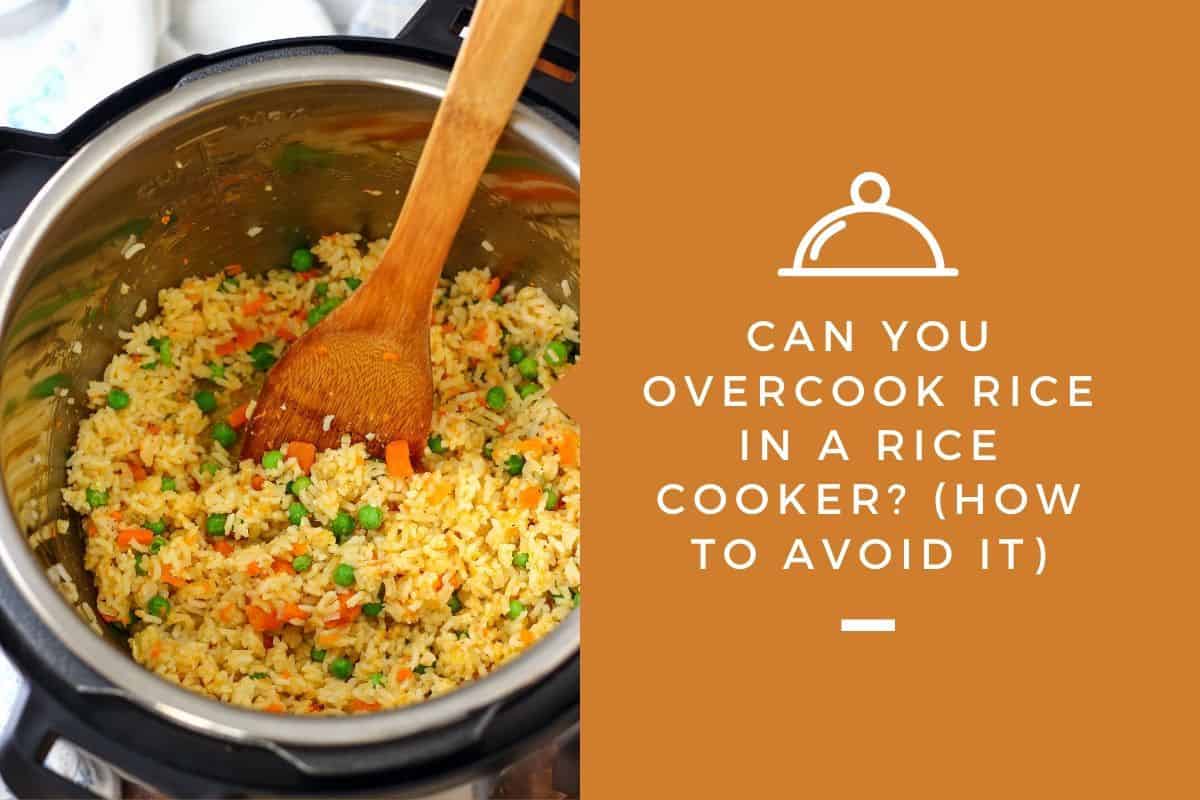When people use a rice cooker, they expect it to make preparing rice simple and foolproof, which is the entire selling point of this popular appliance. As a result, if you’ve been having repeated issues with overcooking your rice in a rice cooker until it’s tough, dry, or even burned, it can be very frustrating not knowing how to fix the issue.
Can you overcook rice in a rice cooker? If you are consistently overcooking rice when using a rice cooker and want to know how to avoid it, you need to address one of the following problems with your methods:
- You’re using the wrong water to rice ratio.
- You’re leaving your rice on the “warmer” setting for too long.
- You’re not using enough rice for the rice cooker to sense.
- Your rice cooker has a malfunction and needs to be replaced.
Having a malfunctioning rice cooker will be the least likely of these options, and before you can assume that’s what’s going with your situation, you need to rule out the other three possibilities. The most likely culprit is that your water to rice ratio isn’t quite right.
Although rice cookers can result in simple food prep that takes little effort, you often need to employ some trial and error to determine the exact water to rice ratio.
Knowing where to start can seem complicated, as rice cookers, packages of rice, and general recommendations can vary, so let’s examine what can change the ratio you should use.
How Rice Cookers Work
Most rice cookers are fairly simple to operate and only have a basic on/off button for you to select. You’re meant to put in a certain amount of dry rice and water into the internal metal pan. Once you close the lid and press the on button, the rice cooker will do the rest.
Rice is cooked by absorbing heated water. Your rice cooker works by using an internal hot plate to raise the temperature of the water inside until it comes to a boil. This process is monitored by a built-in temperature reading device.
Since water can only get so hot (because it will boil off into a gas at 212 degrees Fahrenheit), rice cookers are meant to easily avoid overcooking rice by keeping the internal cooking pan’s temperature consistent as long as there is still water present.
Once all the water is absorbed into the rice or turned into steam, the rice cooker will turn itself off or engage the warmer setting.
How Your Rice Cooker Determines Cooking Time
Most rice cookers have simple mechanisms to determine cook time. When you add the rice and water to the pan, the weight puts pressure onto the temperature sensor and allows the appliance to start cooking once you hit the “on” button.
Then, the sensor waits until the temperature starts to exceed the water’s boiling point, indicating all of the water has been cooked off.
What you might not realize is that certain rice cookers don’t operate on these simple parameters. Instead, it uses complex mathematical calculations coded inside their computer chips to adjust to the amount of rice and water you’ve placed inside the cooking pan. These are known as “fuzzy-logic rice cookers.”
For example, this allows the rice cooker to adjust for how much the internal hot plate produces heat for hotter environmental temperatures that can affect cooking time. Unlike basic rice cooker models, fuzzy-logic models can change the amount of time it takes for your rice to finish cooking.
These models can also have more complicated controls as the computer chip programming they have allows them to adapt the cooking settings to a number of different types of rice.
Although many people might have a general recommendation of what water to rice ratio is optimal, it actually should vary based on the type of rice used.
How to Determine the Right Water to Rice Ratio

If you search online, there are many suggested water to rice ratios that people will say are standard for basic rice cookers or for cooking rice in general, but that’s not quite accurate.
The ratio that you should use will depend on two factors: what model rice cooker you’re using and what type of rice you want to cook.
The Right Ratio for Your Rice Cooker
Each rice cooker should come with a manual that tells you the proper water to rice ratio. Even within brands, there may be some variation between models on what yields the best-cooked rice, so you need to play around with the amounts of rice and water you add.
One thing to keep in mind is that some rice cookers require a minimum amount of rice to cook properly. If you’re using one of these models, even if you’re using the right water to rice ratio, your rice will still end up overcooked because the appliance isn’t made to cook that little rice properly.
The most common type of rice eaten in the is long-grain, white rice, so usually, if you see a “standard” water to rice ratio, it’s most likely assumed you would be using this type of rice. A common ratio you will see recommended is 2 cups of water for every 1 cup of rice.
Before you put both in the rice cooker, however, it’s recommended that you rinse your rice first. For many types of rice, especially variants of white rice, this will remove excess starch, which will help reduce the stickiness of the cooked rice. It’s also a good idea to rinse less-starchy rice to remove any debris or dust that might still be on the grains.
Although a 2:1 water to rice ratio may work perfectly for your long-grain, white rice, you still might need to change up the amount if your rice cooker doesn’t yield results you’re happy with. If you’re still getting overcooked rice, increase the amount of water in the ratio each time until you have perfectly cooked rice. If the rice is mushy, reduce the amount of water you use.
The Right Ratio for Different Types of Rice
If you decide to cook other types of rice, you’ll need to know what water to rice ratio is right for whichever one you’re cooking. Different species of rice will absorb water at different rates, so some types of rice will need more or less water relative to how much long-grain, white rice needs in your rice cooker.
These are the water to rice ratios of commonly cooked types of rice:
- White Rice
- Long-grain – 2 cups water to 1 cup rice
- Medium-grain – 1 ½ cups water to 1 cup rice
- Short-grain – 1 ¼ cups water to 1 cup rice
- Brown Rice
- Long-grain – 1 ¾ cups water to 1 cup rice
- Medium-grain – 2 cups water to 1 cup rice
- Short-grain – 2 cups water to 1 cup rice
- Sushi rice – 1 1/3 water to 1 cup rice
- Basmati – 1 ½ water to 1 cup rice
- Jasmine – 1 ¾ water to 1 cup rice
- Wild Rice – 2 cups water to 1 cup rice
These recommendations are places for you to start, but you’ll still need to make adjustments if your rice cooker doesn’t yield the results that you want.
The amount of time that it takes for each of these types of rice to cook ranges from 15 to 50 minutes, as the rate at which they each absorb water varies. Jasmine, basmati and white rice tend to cook the fastest, while sushi, brown and wild rice can take two to three times as long.
How You Should Use the Warmer Setting
Finally, when using your rice cooker, you need to be careful about how you use the warmer setting. This option allows your rice to be kept warm if not immediately remove from the rice cooker, but you shouldn’t leave your rice inside indefinitely if the warmer setting is engaged.
It’s often recommended that you leave your rice inside the rice cooker for 10 minutes after the warmer setting turns on. This allows more of the steam incorporates into the grains and increases the moisture the rice retains. Then, when you take the rice out, you can use a fork to “fluff” the rice and get an enjoyable texture that avoids being too dry or too mushy.
If you know that you won’t be able to take rice that you have cooking out of the rice cooker quickly enough, try disengaging the warmer setting if yours has that option. Although the warmer setting is not meant to continue cooking the rice, if you leave it in their long enough, the rice cooker will eventually begin to dry out or burn your rice.
Conclusion
It may take some work to find the perfect method to cook rice in your specific rice cooker, but if you start with the right water to rice ratio for the model and type of rice you’re using, you should be able to figure out how to avoid overcooking your rice.
If you’ve tried various ratios without success and you’re not overusing the warmer setting on your rice cooker, then it’s time for you to consider you may have a faulty appliance. Check your warranty and see if you can get yours replaced.
Rice cookers are fairly reliable and sturdy tools to have in the kitchen, and you’re sure to get the perfectly cooked rice you want when trying out these tips with your replacement.

